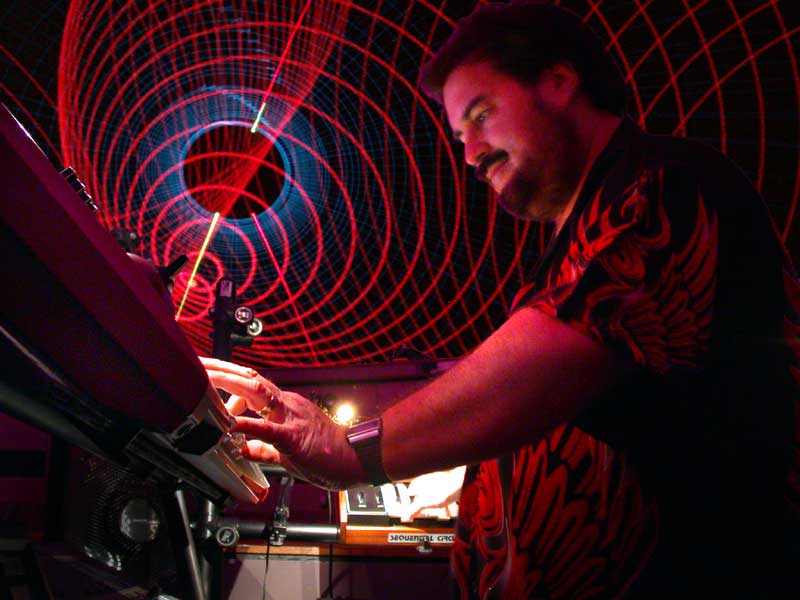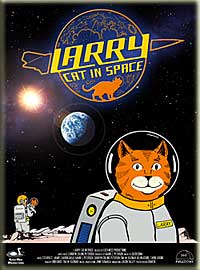
Mark C. Petersen in concert at Boston’s Hayden Planetarium, performing his GEODESIUM music. Photograph by Carolyn Collins Petersen.
What do you call a pair of people who have been crazy enough to spend their entire adult lives working to bring the wonders of the universe to domed theaters? In 1978, we got married under the stars in a planetarium. By then, we’d already been “doing” Loch Ness Productions for about a year. Our main products were albums of Mark C. Petersen’s Geodesium space music. He’s a music educator and experienced composer, and had already been creating planetarium space music for a few years before we started the company.
Fast-forward three and a half decades, and today we’re doing a lot of work throughout the science outreach community, in addition to the planetarium (now fulldome) shows we’re known for. Over the years, people in other areas of outreach have invited us to work with them on some exciting projects, including exhibits at Griffith Observatory, the California Academy of Sciences, and NASA’s Jet Propulsion Laboratory, podcasts for the Astronomical Society of the Pacific, and videos for MIT’s Haystack Observatory. And, we’re still doing space music.
It’s worth looking at where we (and all of our colleagues in the domed theater community) have come from, to see where we’re going. When we at LNP first started creating show content, we shipped scripts and soundtrack packages. That quickly morphed into shipping shows with slides, most of which had to mask and mount by hand. We shipped more than a million slides over the years, before film and mounts disappeared a few years ago. Planetarians used to drop those slides into carousel projectors, panoramas, all-sky systems, and special effects projectors.

Larry Cat in Space is one of 11 shows we’ve created that migrated to fulldome video. It continues to be a popular program for families and school kids.
It has only been a little over a decade since fulldome digital theaters came into being. When they did, the handwriting was on the wall for the older, classic planetarium theaters.
Our shows have been—and continue to be— embedded in school district curricula and museum theater repertories. Moving those classic shows to fulldome was a learning experience, and I’m glad we did it. Our future shows will be more fully 3D animation, which is an entirely more complex and exciting process.
Over the decades, we’ve naturally compiled data about fulldome theaters around the world, and we publish that data as the LNP Fulldome Theater Compendium online. We estimate there are at least 1,400 digital fulldome theaters in the world that we know about. There could be another thousand out there, and we know the numbers are growing. That has changed the way we create and ship shows.
We also curate the world’s first, most accurate and up-to-date database of fulldome content created specifically for the fulldome medium. It’s called the Fulldome Show Compendium and contains entries for 282 shows from 83 producers.
Last week I saw a very tangible result of the changes enveloping the domed community. We were sending a copy of our Season of Light winter holiday show to a customer and Mark came up to show me the packaging before it went out. “Remember back when we used to ship slides and tapes in giant boxes?” he asked. I had to laugh because he was holding a new acquisition for us—little vinyl pouches that can hold about a business-card-sized print graphic, and a USB key. We’ve been searching for a simple, easy form of product identification and packaging for the keys, which are getting smaller and smaller. Anyway, that’s what I’m holding in the picture. The USB key holds the entire show for a medium-sized theater with a Spitz SciDome XD fulldome system.
Today, we’re not quite to the point where we can ship full-length fulldome shows efficiently over the Internet. But shorter shows, for smaller theaters, absolutely. We currently have two downloadable short shows: Light Echoes, from Geodesium “Stella Novus” (a space music video) and Losing the Dark, our light-pollution PSA produced in collaboration with the International Dark-Sky Association. And, they’re both free for the download!
Yes, things have changed and they’ll continue to do so. Doing digital content for domes, exhibits, and online videos has been—and will continue to be—an exciting ride for us as we spread the word about astronomy and space science.


